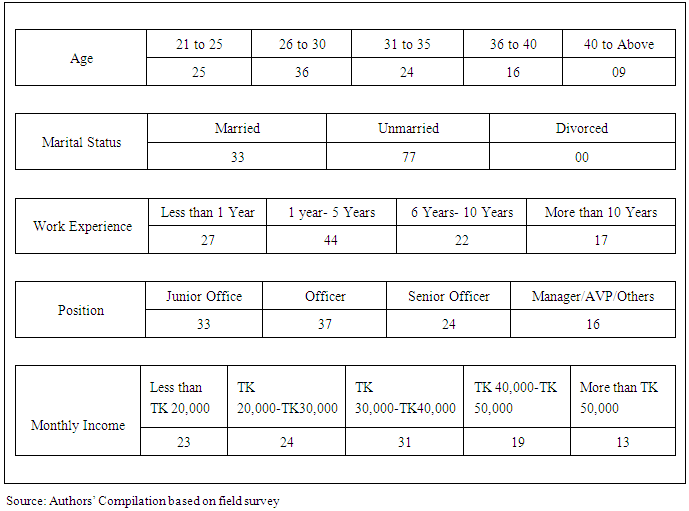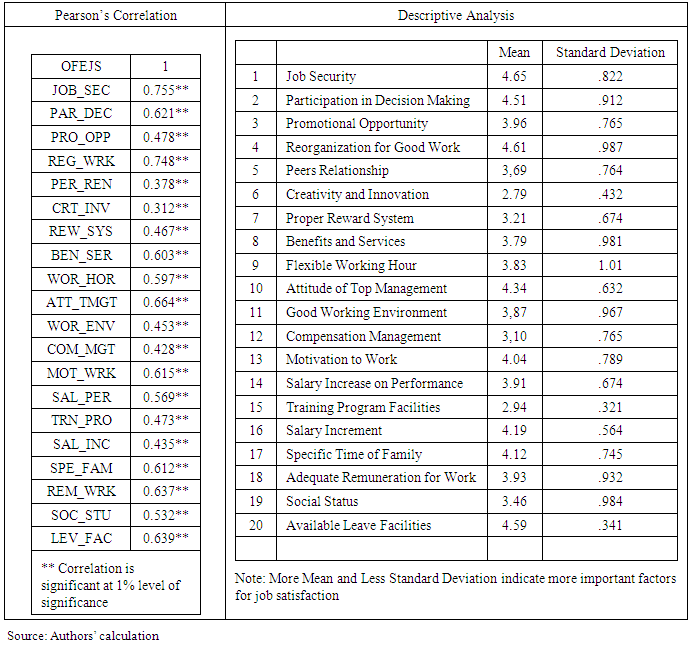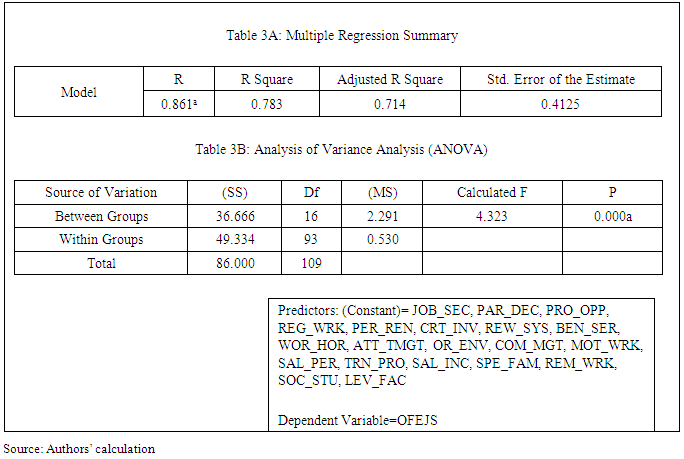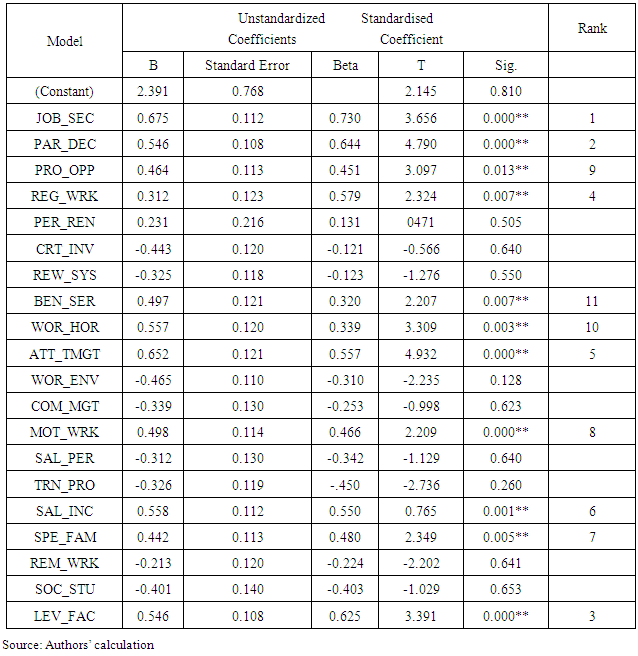-
Paper Information
- Previous Paper
- Paper Submission
-
Journal Information
- About This Journal
- Editorial Board
- Current Issue
- Archive
- Author Guidelines
- Contact Us
Human Resource Management Research
p-ISSN: 2169-9607 e-ISSN: 2169-9666
2016; 6(3): 65-72
doi:10.5923/j.hrmr.20160603.02

Factors Affecting Job Satisfaction of Female Employees of Private Commercial Banks in Bangladesh: An Empirical Investigation
Abu Naser Mohammad Saif1, Md. Bashir Uddin2, A. K. M. Ahasanul Haque2, Md. Mizanur Rahman3, Mohammad Abdullah Al Mamun4
1Department of Management Information Systems, Faculty of Business Studies, University of Dhaka, Bangladesh
2Kulliyyah of Economics and Management Sciences, International Islamic University of Malaysia (IIUM), Malaysia
3Department of Management & Marketing, Faculty of Economics and Management, Universiti Putra Malaysia (UPM), Malaysia
4School of Business Studies, Southeast University, Dhaka, Bangladesh
Correspondence to: Abu Naser Mohammad Saif, Department of Management Information Systems, Faculty of Business Studies, University of Dhaka, Bangladesh.
| Email: |  |
Copyright © 2016 Scientific & Academic Publishing. All Rights Reserved.
This work is licensed under the Creative Commons Attribution International License (CC BY).
http://creativecommons.org/licenses/by/4.0/

Job satisfaction is the most extensively discussed issue in Organizational Behavior, Human Resource Management, and Organizational Management. This study aims at indentifying some important factors that affect job satisfaction of female employees of private commercial banks in Bangladesh. A highly structured questionnaire was prepared to collect primary data from 110 female employees working at private commercial banks in Bangladesh. Several statistical tools and techniques, i.e. Descriptive Analysis, ANOVA, Pearson Correlation, and Multiple Regression have been used to determine authentic findings and draw a significant conclusion. The findings of the study reveal significant factors, i.e. job security, participation in decision making, available leave facilities, attitude of top management, salary increment, specific time for family, promotion opportunity, flexible working hour etc. affect job satisfaction of female employees of private commercial banks. Hence, the authority should address those key factors properly for the development of private commercial banking sector in Bangladesh.
Keywords: Bank, Female, Employees, Job Satisfaction
Cite this paper: Abu Naser Mohammad Saif, Md. Bashir Uddin, A. K. M. Ahasanul Haque, Md. Mizanur Rahman, Mohammad Abdullah Al Mamun, Factors Affecting Job Satisfaction of Female Employees of Private Commercial Banks in Bangladesh: An Empirical Investigation, Human Resource Management Research, Vol. 6 No. 3, 2016, pp. 65-72. doi: 10.5923/j.hrmr.20160603.02.
Article Outline
1. Introduction
- Now a day, success of an organization totally depends on human resources division. A fundamental part of human (Male and Female) life is to spend in the workplace of any organization. A country’s overall development depends on the equal contribution of male and female. Total population of Bangladesh is 14, 97, 72, 364 and the ratio of male and female are 100:103 (Population and Housing Census 2011). Women are about half of the direct and indirect labor forces and thus half of the development of Bangladesh depends on them. Very recently women are trying to involve themselves as employees of different financial institutions especially in banking sector. In any economy of a country, banking sector plays a vital role for overall development of agriculture, small business and different industries of a country. Bangladesh is on its way to development. Banks, particularly private commercial banks have significant contribution in the development process. There are almost 47 private commercial banks in Bangladesh (Banking Diploma Examination) and here lots of female employees’ are working. According to a Bangladesh Bank (BB) data, around 13.08% of women work at entry level in the banking industry, but less at mid-level 8.58% and 4.44% work at senior management level In the banking sector, about 15.57% of women employees are there in the below-thirty age group. The percentage of female Board Members totaled came to only 9.73% in 2011. So, it is of greater interest to know why female employees work at banking sectors and at which levels and how far they satisfied with their jobs. Simply, satisfaction is a mental state of human being. But, job satisfaction refers to the positive feeling regarding specific tasks to his or her job. On the basis of the human behavior, employees are more interested to do work in those organizations form where they get more mental satisfaction. There are a variety of factors that can influence the level of job satisfaction of female employees i.e. Job security, participation in decision making, available leave facilities, reorganization of good work, attitude of top management, salary increment, specific time for family, motivation to work, promotional opportunity, flexible working hour, benefits and services, training program facilities, compensation management, creativity and innovation, proper reward system, working environment etc. From the earlier information (47 Private commercial banks) it is seen private commercial banking sector is very competitive. (Mizan et al., 2013) said the environment of banking sectors in Bangladesh is fairly competitive and they need to ensure the employees job satisfaction to perform efficiently. These competitive advantages largely depend on female employees’ job satisfaction. So, banking authority should focus on those jobs related factors which can ensure job satisfaction of female employees. After reviewing vast literatures and completing introduction the researchers have decided to develop a research model.
1.1. Objectives of the Study
- The objectives of this study are as follows:i. To find out the differences among the factors related to job satisfaction.ii. To evaluate the correlation between job satisfaction and factors of job satisfaction
1.2. Methodology of the Study
- This research incorporated a qualitative and quantitative research approach based on a structured questionnaire. A total number of 110 female employees of different private commercial banks have been randomly selected from 11 private commercial banks in Sylhet city, Bangladesh. In this paper, the researchers have used a structured questionnaire for collecting primary data. 31 job satisfaction related factors were taken as independent variables and overall job satisfaction as dependent variable. In this study Microsoft Excel and Statistical Package for the Social Science (SPSS) have been used as statistical tool to process and analyze the collected data. The five-point Likert scale ranging from 1 - strongly disagree to 5 - strongly agree was used for the questions to indicate the degree of agreement or disagreement with each of a series of statements related to the stimulus objects of the study. Different statistical tools and techniques have been used to analyze the collected data. At first the researchers decided to conduct Pearson’s correlation to find out the relationship between independent variables and dependent variables. According to the results of Pearson’s correlation it was found that 20 factors had positive association with female employees’ job satisfaction. Later on the researchers did not consider the rest 11 job satisfaction related factors for conducting other analyses i.e. Descriptive analysis (to know the overall scenario of job satisfaction related factors on the basis of mean and standard deviation), Multiple Regression analysis (to know the significance level of job satisfaction related factors with over all female bank employees satisfaction). Secondary data were collected from different local and international articles and journals, books, and websites.
2. Literature Review
- Job satisfaction has been widely studied over the years. Around the sphere, it is an established fact that a person with a high level of job satisfaction shows positive attitude towards the job, while a person who is dissatisfied with the job has a negative attitude. Job satisfaction is in regard to one’s feelings or state of mind regarding to the nature of their work (Shamima Tasnim, 2006). Job satisfaction can be considered as a global feeling about the job or as a related constellation of attitudes about various aspects or facets of the job (Kovach, 1977; Spector, 1997). Positive and negative emotions were also found to be significantly related to overall job satisfaction (Fisher D, 2000). Numerous studies have shown that dissatisfied employees are more likely to quit their jobs or be absent than satisfied employees (Hackett & Guion, 1985; Hulin, Roznowski, & Hachiya, 1985; Kohler & Mathieu, 1993). There are some job related factors which can ensure job satisfaction such as supervision, pay, promotion opportunities, coworkers and so forth, the nature of the work itself generally emerges as the most important job facet (Judge & Church, 2000; Jurgensen, 1978). The source of this job satisfaction not only arises from the job but also from the other factors like- work environment (both physical and social), relationship with supervisors & peers, corporate culture, managerial style. (Uddin et al., 2005) also identified eight factors based on factor loadings named as better working environment, officer’s view, worked efficiently, present work, improving interpersonal relationship, bank treatment, colleagues and challenging work. These factors have different impact on different people and in practical world it is an established fact that gender differences also influence the job satisfaction level. The comparison of job attitudes between men and women is of less interest than a study of the effects of the societal roles of men and women on their attitudes toward jobs (Herzberg et al., 1957). They also reported that the job adjustment of female workers is often made more difficult because they must divide their interests and attention between the working world and their traditional role and that the social and psychological pressures toward marriage complicate the job attitudes of the unmarried female. They take up their jobs primarily for their livelihood, which is conditioned by job satisfaction (Locke, 1976). Women are intrinsically more satisfied than men (McNeely, 1984). (Greenberg et al., 1993) reported that employed women, in general, seem to be less satisfied with their work than their counterpart men. On the other hand, (Campbell et al., 1976) reported that single men are less job satisfied than married men, but that no such difference exists for females. After reviewing vast literatures the researchers found a variety of job characteristics or aspects are responsible to make sure their job satisfaction. These characteristics include occupational prestige, earnings, education, job complexity, level of authority exercised, how closely the worker is supervised, job pressure, being held responsible for things outside one’s control, how frequently one has to get dirty on the job, being underemployed, workplace size, and level of optimism about one’s future at the current job. On the basis of above introduction and literature review, the researchers have formulated a research model which is shown below. The research model shows how independent variables hypothetically affect the dependent variables. The formulated fundamental hypothesis is: H0A: Job related factors do not affect female employees’ job satisfaction.And the supporting hypotheses are:H1: Job security affects female employees’ job satisfaction.H2: Participation in decision making affects female employees’ job satisfaction.H3: Promotional opportunity affects female employees’ job satisfaction.H4: Reorganization for good work affects female employees’ job satisfaction.H5: Peers relationship affects female employees’ job satisfactionH6: Creativity and innovation affects female employees’ job satisfaction.H7: Proper reward system affects female employees’ job satisfaction.H8: Benefits and services affect female employees’ job satisfaction.H9: Flexible working hour affects female employees’ job satisfaction.H10: Attitude of Top management affects female employees’ job satisfactionH11: Good working environment affects female employees’ job satisfactionH12: Compensation management affects female employees’ job satisfaction.H13: Motivation to work affects female employees’ job satisfaction.H14: Salary increase on performance affects female employees’ job satisfaction.H15: Training program facilities affects female employees’ job satisfaction.H16: Salary increment affects female employees’ job satisfaction.H17: Specific time for family affects female employees’ job satisfaction.H18: Adequate remuneration for work affects female employees’ job satisfaction.H19: Social status affects female employees’ job satisfaction.H20: Available leave facilities affect female employees’ job satisfaction.
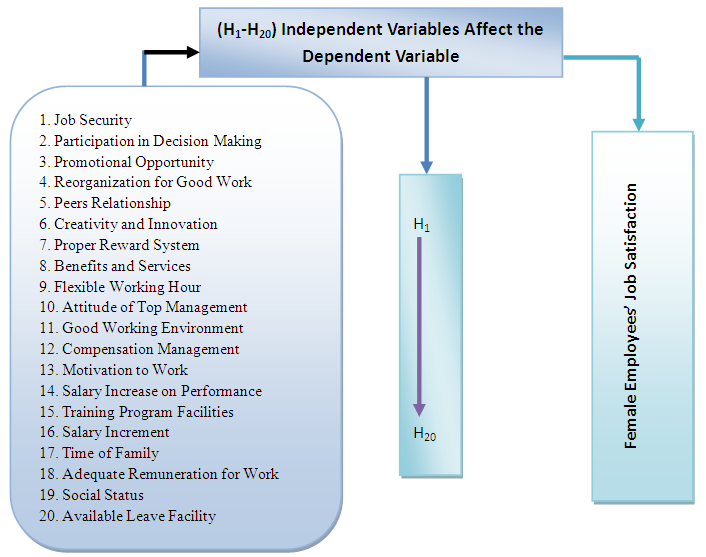 | Source: Authors’ Compilation |
3. Model of the Study
- The researchers have already found 20 important factors which have positive association with job satisfaction of female bank employees’. Now the researchers have decided to know the significant impact of these factors on overall job satisfaction of female bank employees’. So, the researchers decided to conduct multiple regression analysis. The regression model for the study is as follows- OFEJS = α+ β1X1+ β2X2+ β3X3+ β4X4+ β5X5+ β6X6+ β7X7+β8X8+ β9X9+ β10X10+ β11X11+ β12X12+ β13X13+ β14X14+ β15X15+ β16X16+ β17X17+ β18X18+ β19X19+ β20X20+ β21X21+Єt Where,OFEJS =Overall Female Employees’ Job Satisfaction
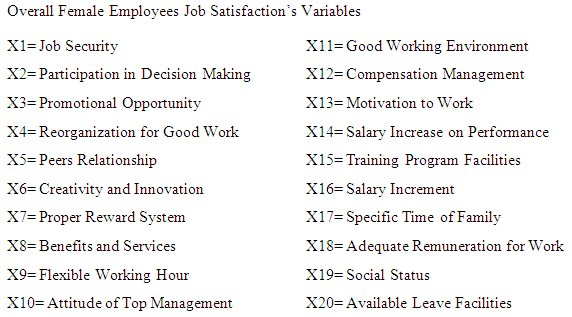 Єt= Error TermAnd α is a constant and β1, β2, β3, β4, β5, β6, β7, β8, β9, β10, β11, β12, β13, β14, β15, β16, β17, β18, β19, β20 are coefficient to estimate.
Єt= Error TermAnd α is a constant and β1, β2, β3, β4, β5, β6, β7, β8, β9, β10, β11, β12, β13, β14, β15, β16, β17, β18, β19, β20 are coefficient to estimate.4. Empirical Analysis and Results
- The given table 1 reveals the respondent’s demographic information. The most information has collected from the age range of 26 to 30 (36 respondents) and most of the respondents (77) were unmarried.
|
|
|
|
|
5. Conclusions
- In terms of job satisfaction most of the academicians and researchers have conducted their research on industrial workers, service organization’s employees and other sectors. Few attempts have been taken in case of measuring job satisfaction of female bank employees. Nowadays female participation is encouraged in workplace, especially in the financial institutions like private commercial banks where suitable environment has been perceived. To sustain the increasing part of employees (female employees) it becomes important to measure the job satisfaction of female employees. The equal contribution of male and female in any financial organization especially banking organization is very important for the development of overall economy of a developing country like Bangladesh. So, proper guidance, policies and practices need to be developed to ensure the female bank employees’ job satisfaction. A list of 31 common banking job related factors used in this study. In the conclusion of this study it can be said that the female employees’ overall job satisfaction of private commercial banks in Bangladesh is associated with 11 variables i.e. for job security, participation in decision making, available leave facilities, reorganization of good work, attitude of top management, salary increment, specific time for family, motivation to work, promotional opportunity, flexible working hour, benefits and services. If these factors are considered carefully, then there will be positive overall satisfaction on female employees of private commercial banks in Bangladesh. From the study this is a message for the higher level managers of private commercial banks that if they want to improve the job satisfaction of female employees in banks then they have to consider the above 11 variables shown in table 4. Although correlation analysis shows relationship of some other variables with the job satisfaction of female employees, the ANOVA does not imply significance, thus those variables have been excluded from the model development. This study may therefore lacks in revealing complete forces of variables in job satisfaction.
 Abstract
Abstract Reference
Reference Full-Text PDF
Full-Text PDF Full-text HTML
Full-text HTML